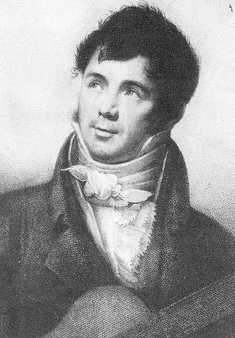 Fernando Sor
Fernando Sor
(1778-1839)
Fernando Sor
(1778-1839)
Fernando Sor, one of the great figures in the history of the guitar, was an all-round musician and composer.
|
|
Fernando Sor |
Although he was acknowledged in his lifetime as a fine performer ("Sor ... who is known to be the most perfect guitarist in the world", wrote Ebers in London), he was not associated with that instrument as strongly as was, for example, Giuliani. He had been a chorister at the monastery of Montserrat (near Barcelona), where he received an education in church music and composition and in orchestral playing, and later in life he composed music not only for the guitar but also for voice, piano, orchestra, etc.
Until 1813 (when he was 35) he lived entirely in Spain. He composed seguidillas there for voice and guitar (some with piano), symphonies, operas, and some guitar music such as the famous piece now known as Grand Solo, op. 14 and the Sonata op. 22. He fought in the Spanish War of Independence when Napoleon invaded Spain in 1808.
After a brief stay in Paris in 1813, Sor settled in London where he published his marvellous and justly celebrated set of studies now known as op. 6, the Variations on a Theme of Mozart, and many other works such as Italian Arietts for voice and piano. A journey to Moscow followed and Sor then spent the rest of his life in Paris. He became a teacher of the guitar and it was there that he composed the many works for beginners on the guitar - op. 31, 35, and 60 - which have been called the finest works ever written for beginners on the instrument.
Gran solo op. 14 is a free fantasy in which the themes recur, rather than a work in a strict sonata form. A grandiose and large-scale piece in a single movement. It uses the guitar to the full.
Sonata op. 22 has four movements: allegro, adagio, minuetto and rondo. As in Gran Solo the first movement moves freely from key to key; on the first page we move suddenly from C to E-flat major. This sonata is an early work by Sor. Sonata op. 22 is dedicated to Manuel Godoy ( The prince of the Peace). Godoy was prime minister of Spain and settled peace with France in 1795. Soriano Fuentes wrote on Sors early style in relation the the sonata: " En un pricipio su gusto fué tan enérgico, que se le puede llamar soberbio, como se ve en la obra que dedicó al la principe de la paz"( Historia de la Música Espanõla, IV, p. 211). ("At first his style was so energetic that one can call it magnificent. ")
Brian Jeffery
A Dutchman who heard Mauro Giuliani in 1808 when he had first arrived in Vienna from Italy, had a perceptive insight into the nature of Giuliani's work. He wrote: "Then I heard a guitarist who played so perfectly that he often reminded me of the fine old time of true lute playing"
In Giuliani's early and virtuoso period he composed a Sonata for solo guitar; his first concerto, op. 30; and his Studio for the guitar, a tutor which was much prized and whose right and left hand exercises have never ceased to be used since that time.
After that brilliant beginning, Giuliani settled down to composing steadily for many years in Vienna. He moved in the thick of Viennese musical society: Beethoven, Hummel, Mayseder, etc. He played in the first performance of Beethoven's Sixth Symphony. There is no sharp dividing line between the first period and this one, but one could say that this second period has two characteristics. First, it is a consolidation: an achievement which established Giuliani as the principal guitarist in Vienna and one with a serious and solid reputation. Secondly, it established him as an all-round musician, as a composer not only for the guitar but for guitar and flute or violin, guitar and voice, as well as two more guitar concertos. From this period is his Grande Ouverture in the Italian style.
During all this time, he had Italian influence on his music. Now in 1819 he left Vienna for Italy. First to Venice (where he stayed in the Hotel de Gran Bretania, still in existence). In this later period he composed some fine works. Particularly strong was the influence of Rossini.
(Giuliani wrote only one three-movement sonata in the traditional classical manner. His sonata op. 15, stands like a solitary gem in the literature for classical guitar. The first movement is a monthemathic sonata form (not unlike Haydn's quartet op.74 no. 1). The development section is admirable for its new melodic ideas, and distant harmonies. It is skilfully worked into the whole, and thus leaves the listener with the impression that nothing could have been more carefully composed. It is a kind of movement not a note of which could be revised, ( Thomas Heck, the birth of the classic guitar VL 1, p. 213-214)
Brian Jeffery